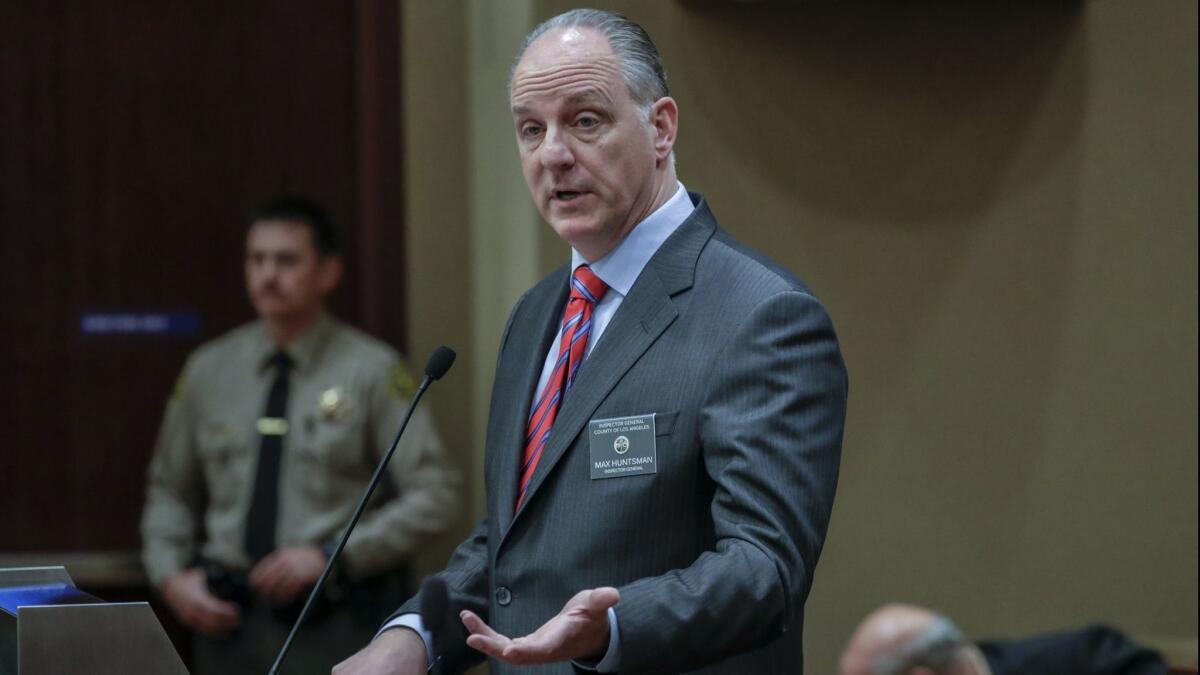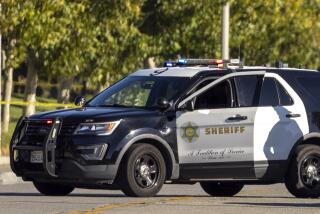Editorial: Important lessons from the sheriff’s oversight commission — and the election

- Share via
As ballots were still being counted Thursday in the very close race for Los Angeles County sheriff, the county’s inspector general stood before the civilian commission that oversees the Sheriff’s Department and delivered a startling report on a controversial operation to stop and search cars on “the Grapevine” on Interstate 5, which The Times first brought to light on Oct. 7. It was followed by an equally disturbing report on alleged secret societies in the department. There are some key points to take from the morning’s discussion.
First, we don’t yet know whether the four deputies who stopped a disproportionate number of Latino drivers did so because of improper racial profiling, implicit bias, or some other scheme or system based on ethnicity. Inspector General Max Huntsman’s investigation will take several months.
But what we do know now is bad enough, at least according to Huntsman: Federal court rulings and settlements have previously found that deputies violated the constitutional rights of drivers by detaining them for unreasonable periods of time without evidence of wrongdoing. In fact, complaints against deputies in Antelope Valley and in the Grapevine operation itself, which has been in progress since 2012, have led to several such findings and one court settlement in recent years. That means that as the behavior continued in the Grapevine, there was either a conscious tolerance among department leaders of continuing misconduct, or a failure to adequately supervise the operation.
The civilian oversight commission is a valuable asset that, for all its quirks and lack of enforcement authority, has become indispensable.
Law enforcement officers are permitted to stop drivers and to detain them for a brief amount of time, but not as a pretext to conduct an otherwise unlawful search or to improperly elicit consent for a search.
Next, patrol cars involved in the Grapevine operation were equipped with dashboard cameras, and at some point they were live. We know that because some of the footage was used in federal court to challenge the deputies’ version of events in at least one of the stops. We also know that at some point the dashcams were shut off, and no more footage was available. The department should explain why.
From a later discussion at the commission Thursday, we know that the county counsel, the inspector general and the commission are investigating whether there remain in the department deputy “cliques” — or gangs, or secret societies — with their own shadow training, rules, hierarchies and subcultures, operating outside of and contrary to the orders of the elected sheriff and the chain of command. This supplements the inquiry that Sheriff Jim McDonnell promised the commission in August, in the wake of a Times story reporting a deputy’s admission that he got a tattoo as part of a ritual in the sheriff’s Compton station.
In some sense, though, these revelations are beside the point. The core issue comes into focus only when we imagine what might have happened if these matters had come up just two years ago, before the Los Angeles County Sheriff’s Civilian Oversight Commission was created and the first appointees seated. If The Times had reported then on the Grapevine operation, or the gang-like tattoos, who would have followed up?
Enter the Fray: First takes on the news of the minute from L.A. Times Opinion »
There were monitors and advisors in place, one of whom reported to the sheriff, another to the Board of Supervisors. But there was no public body focused specifically on sheriff’s oversight, no place at which the sheriff was pressured to send a representative or show up in person to answer questions, no forum for an inspector general to publicly detail preliminary findings and freely offer his own opinion on what the department was doing right — or wrong.
The chief takeaway from Thursday’s meeting, and the host of meetings that came before, is that the civilian oversight commission is a valuable asset that, for all its quirks and lack of enforcement authority, has become an indispensable part of the county structure.
That brings us back to the election, in which challenger Alex Villanueva’s current lead may hold, or McDonnell may somehow pull out a reelection victory. The days in which an incumbent sheriff can run the department outside public scrutiny and with assurance of easy reelection are over. That’s welcome news, no matter who serves as sheriff for the next four years.
Follow the Opinion section on Twitter @latimesopinion and Facebook
More to Read
A cure for the common opinion
Get thought-provoking perspectives with our weekly newsletter.
You may occasionally receive promotional content from the Los Angeles Times.










